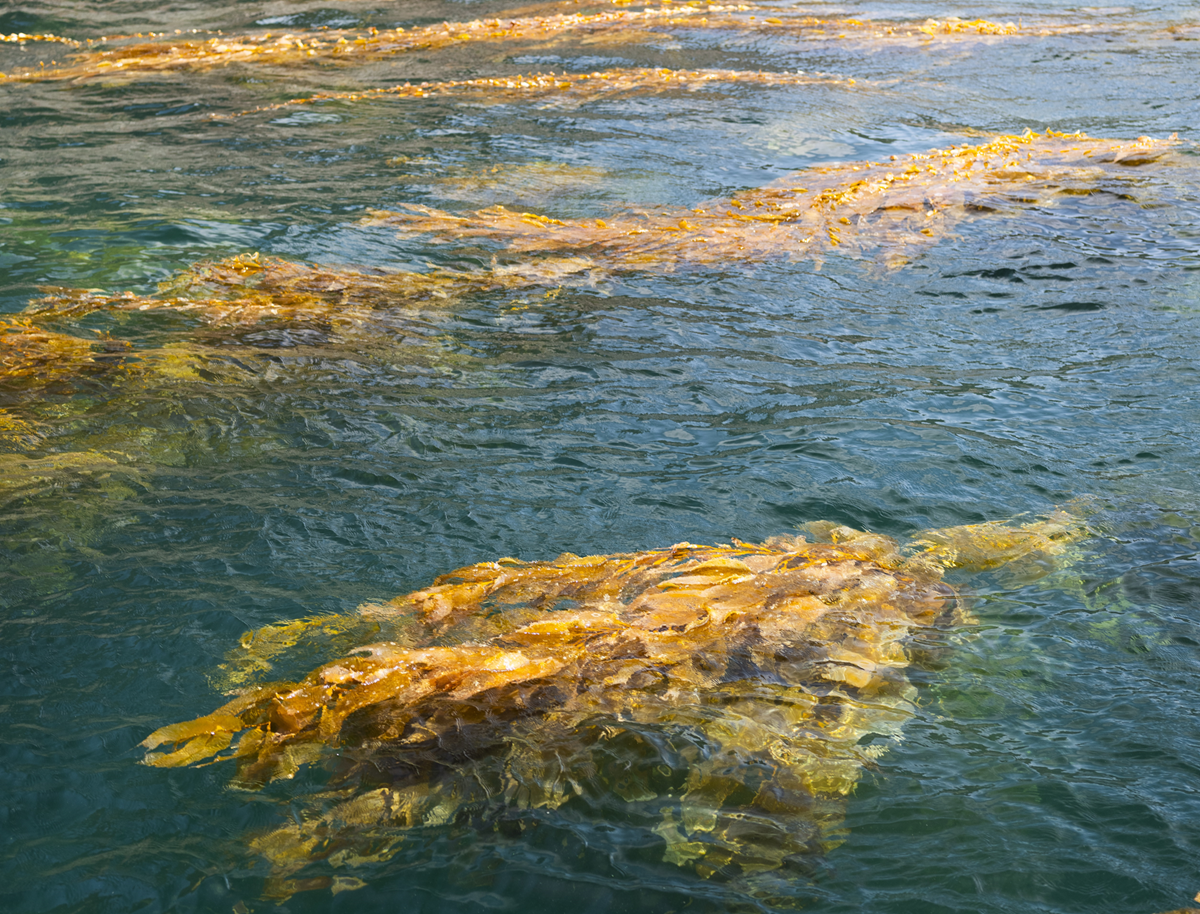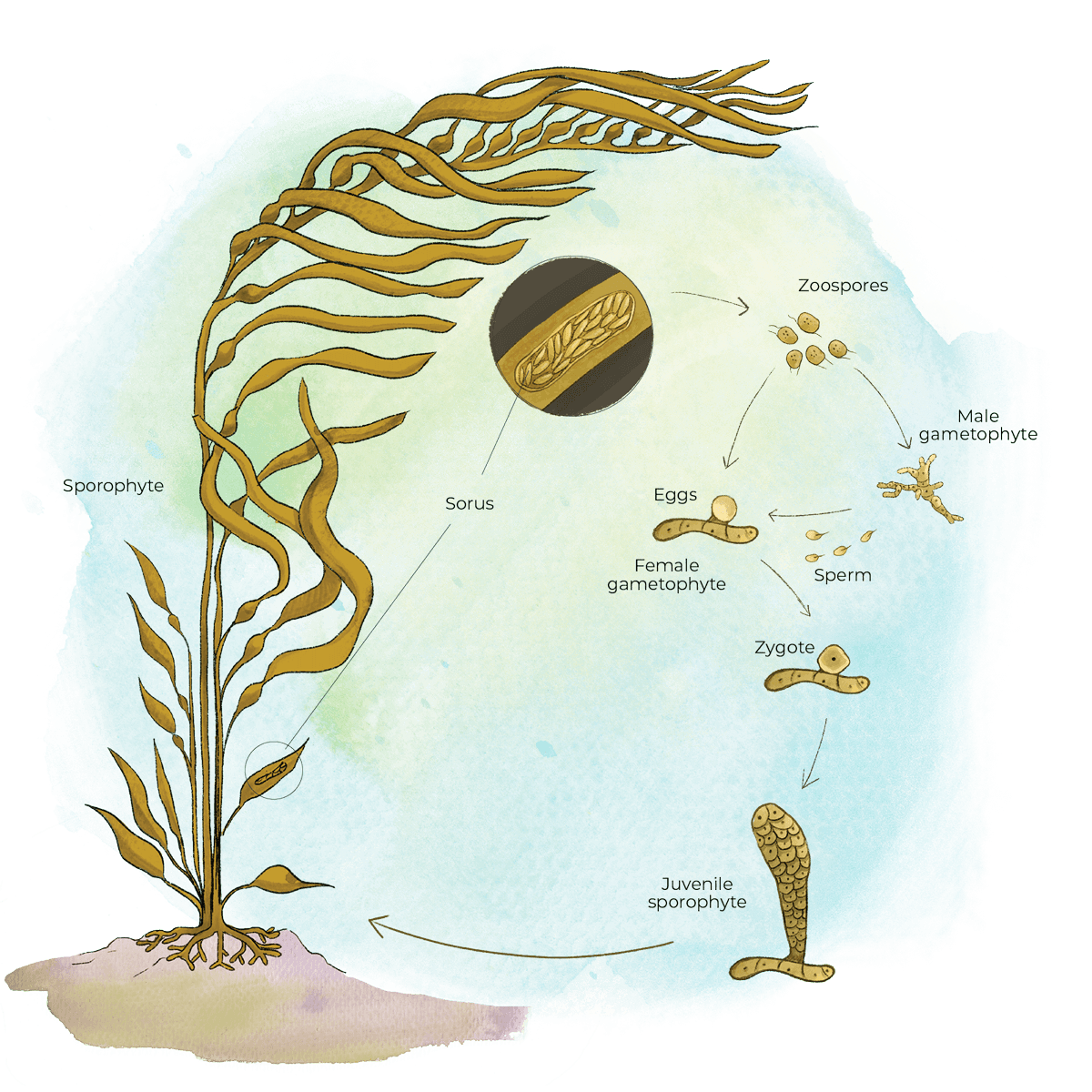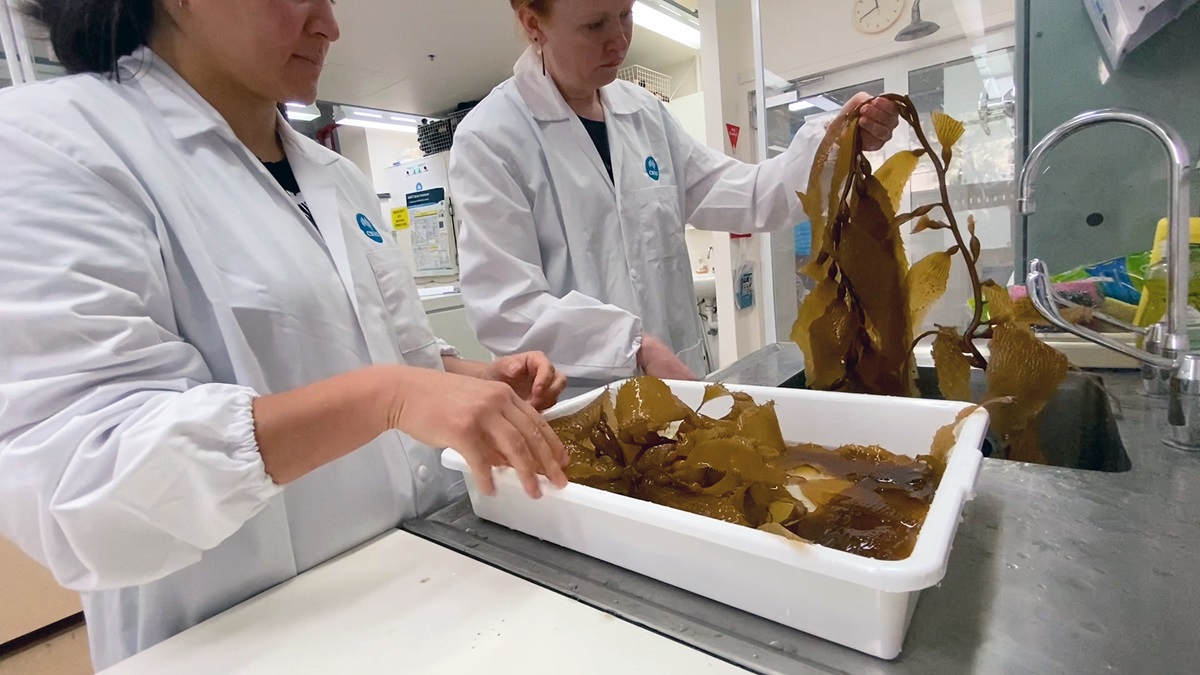Tasmania was once surrounded by majestic forests where sea creatures lived in the quiet beauty among towering tangles of Giant Kelp.
But as our climate changes, the seas around Tasmania have warmed and the East Australian Current has flowed further south. This has brought nutrient-poor waters and invading sea urchins to Tasmania.
Warm waters, low nutrients and sea urchins are deadly to Giant Kelp.
In recent decades, the once widespread forests of Giant Kelp around Tasmania have declined by 95 per cent.
Giant Kelp Forest is now listed as an endangered marine community type.

© Illustration by Rachel Tribout
A giant among seaweeds
Giant Kelp (Macrocystis pyrifera) is a species of seaweed, or macroalgae. It grows in cold, shallow seas around the world, from California to New Zealand. Giant Kelp individuals can reach well over 50 metres tall.
In the shallow seas around Tasmania, Giant Kelp grows to around 30 metres tall.
At its base, Giant Kelp has a holdfast to attach to rocks or hard substrate on the sea floor. Long stems, called stipes, grow toward the surface. Leaf-like blades grow along the stipes, with gas bladders at their base to help them float.

On the surface of the sea, blades of giant kelp fold and bathe in the sun and sea spray.

Giant Kelp at Tinderbox Marine Reserve. © Andrew Wilson
No forest without trees
Giant Kelp in the sea are like trees on land. But unlike forests on land, there is only one species creating the forest: Giant Kelp.
The other species in the forest depend on it entirely. The young of many fish species shelter here in nurseries. Octopuses, sea stars and jellyfish carry out their lives. Marine plants and seaweeds grow in niches in the forest. Sea lions weave through the forest and surface in its canopy. A network of insects, like kelp flies, recycle Giant Kelp that has detached and washed ashore at the end of its life.
Without Giant Kelp to form the forests, the entire ecosystem disappears.
Climate change threatens the few remaining strongholds of Giant Kelp in Tasmania. Warming in the Tasman Sea is twice the global average. Giant Kelp is very sensitive to warmer water temperatures.
Tasmania’s shallow seas are the last stop before Antarctica. There is nowhere for Giant Kelp to retreat.
But there is hope.
We are working with partner organisations to restore Tasmania’s giant kelp forests. By breeding giant kelp that is tolerant of warmer water and replanting it in the ocean, we hope to bring back the entire marine community.
Growing giants in the lab
Giant Kelp is huge, but in our laboratory we mostly work with Giant Kelp gametophytes. They are the microscopic stage in the life cycle of Giant Kelp.
When Giant Kelp reach around five metres tall, they begin releasing microscopic spores from special blades at their base, which are called sporophylls.

© Illustration by Rachel Tribout
Spores settle on the sea floor where they mature into microscopic female or male gametophytes and produce eggs or sperm. Fertilised eggs grow into baby Giant Kelp on the female gametophytes.
At its peak, Giant Kelp can grow 50 centimetres in a single day.
Divers take cuttings from the reproductive blades of Giant Kelp individuals to provide gametophytes to culture in the lab.
Under red light at 4 degrees Celsius, gametophytes remain in stasis. We can store them as a biobank, which is like a seed bank of Giant Kelp to help secure the species.

The Giant Kelp biobank at the Institute for Marine and Antarctic Studies (IMAS).
At 12 to 15 degrees, they produce more cells, which we can use for study. Blue light triggers sperm from male gametophytes to fertilise egg cells from female gametophytes.
Our partners grow Giant Kelp babies on lengths of string and plant them in the ocean.
Secrets in the DNA
Thanks to studies at the Institute for Marine and Antarctic Studies (IMAS), we know some Giant Kelp individuals are more tolerant of warmer sea temperatures.
We are using genomics to understand why. One of the techniques we are using is whole genome sequencing. This means looking at the entire DNA sequence of Giant Kelp individuals and testing whether genetic differences are associated with thermal tolerance.
To help analyse the huge and complex data, we are using two Google AI tools: DeepConsensus and DeepVariant.
So far, we have found some initial evidence that thermal tolerance in Giant Kelp does indeed have a genetic basis. This means we’ll be able to use selective breeding techniques to breed thermally tolerant Giant Kelp babies for replanting in the ocean.
As populations of Giant Kelp decline, they risk permanent loss of genetic diversity, further diminishing their chances of survival.
That’s why we’re also looking at the genetic structure of the remnant populations of Giant Kelp in the coastal waters of eastern Tasmania. We want the breeding program to maximise the trait of thermal tolerance while maintaining the full genetic diversity present in Tasmania’s remnant Giant Kelp populations.

Cuttings of Giant Kelp collected from a beach in Hobart.
We have found remnant Giant Kelp populations have more genetic diversity than we expected, which is good news for the species.

We are using DNA extracted from Giant Kelp to study population genetics.
We’ve found genetic differences between the populations in the north-east of Tasmania and the southern populations near Hobart. The southern populations have higher genetic diversity.
Forests of the future
Our ongoing work to understand Giant Kelp populations, and select warm tolerant strains for replanting, will give Tasmania’s Giant Kelp forests the best chance to recover and flourish into the future.
Unravelling the genetics of Giant Kelp could also support farming Giant Kelp for biomass to lock away carbon. Find out how Giant Kelp and other seaweeds hold promise for a net zero future.
Acknowledgements
This project is a partnership between Google Australia (supported by the Digital Future Initiative), CSIRO, the University of Tasmania’s Institute for Marine and Antarctic Studies (IMAS) and The Nature Conservancy (TNC).
CSIRO, IMAS, and Google researchers are using two Google AI tools - DeepConsensus and DeepVariant - to analyse surviving Giant Kelp to understand what makes some of it heat resistant and ensure genetic diversity and increased thermal tolerance in restored forests.
TNC identifies sites most suitable for Giant Kelp restoration. IMAS grows Giant Kelp strains for around six weeks before TNC and IMAS plant the Giant Kelp at the restoration sites using a technique developed by IMAS to attach the juvenile Giant Kelp to the sea floor.
Credits
-
Author
-
Production editor
-
Editor
Summer Goodwin
-
Developer
Kate Cochrane
